Delphinium tricorne
A spring ephemeral with blue star-shaped flowers
Delphinium tricorne dwarf larkspur
This beautiful deep violet native herbaceous perennial is a beautiful sight on the woodland floor. The flowers are often such a dark purple that they blend in with the background of soil, rocks and leaf litter. The dwarf larkspur is actually a member of the buttercup family as demonstrated by the wide and deeply lobed basal leaves typical of buttercups. The genus name comes from the Greek word for 'dolphin' and refers to the shape of the buds that, with imagination, look a bit like dolphins. The blue to deep violet flowers are borne on top of a branchless, fleshy stem. A white variety also exists. The flower stalk is usually lightly hairy and may have a few alternate leaves.
The dwarf larkspur is considered a spring ephemeral and starts blooming in the northeastern United States before the leaves are on the trees, and then soon dies back. It can however bloom to mid-June in cooler and shaded places. It can grow ½–1½ feet high and has a flower spike (raceme) 6-8 inches long with 5 to 24 flowers. The complex star-shaped flowers have 5 very small petals and 5 petal-like sepals and are about ¾ to 1 inch in diameter. Two of the petals surround the opening that leads to the nectar spur. A variety of long-tongued bees, hummingbirds and butterflies as well as the sphinx moth will pollinate this species. The top petal-like sepal forms a long spur that resembles a witch's peaked hat. The scientific epithet 'tricorne' comes from the three horn-like fruit pods that develop later in the season.
Most of the leaves form a loose cluster at the base of the flower stalk. These can be up to 4 inches long and wide. There are a few alternate stem leaves. The larkspur prefers rocky or loamy soil and partial shade. It grows in an area from Pennsylvania and northern Georgia west to Oklahoma and Minnesota. It does not apparently grow as a native plant in New York State or New England. Populations in the Southeast are spotty. Historically the dwarf larkspur has been found mostly in southwestern Pennsylvania, though some have been seen as far north as Venango county. The plant contains toxic alkaloids and should never be eaten. This toxicity is true of most members of the buttercup family.
Habitat & Range
Locally abundant in rich moist woods, thickets, river bluffs and calcareous slopes. Prefers dappled sunlight or part shade and rich, well-drained soil with high organic matter.
Mostly found in the southwest and southcentral parts of the state.
Range: Pennsylvania and northern Georgia west to Oklahoma and Minnesota
Wetland code: Not classified
Phenology
Flowers late April to June.
Characteristics
Inflorescence open terminal raceme with clusters of 5 to 24 spurred flowers; up to 8″ long
Flowers 5 petal-like sepals, 4 very small petals; sepals blue or violet to whitish, petal-like, oval-oblong; upper sepal forms nectar spur, two upper petals extend backward into the spur, two lower petals surround the opening that leads to the spur; ¾–1" across; flower stalk pubescent and ¾" long
Leaves basal and cauline, similar in appearance
Basal leaves simple, sparsely hairy, palmately lobed; first divied into 5 deep lobes, then further into 2 or 3 shallow lobes; on long hairy petioles; 4" long and wide
Stem leaves alternate, clustered near base and just a few; rarely there can be stem leaves further up the stem
Stem erect to lax, branchless,terete (thick & cyclindrical), somewhat fleshy; whitish green or green with red tint; often covered with fine white hairs and less often can be smooth
Fruit 3 horn-like follicles; follicles oblongoid, angular, glabrous, 1.2-1.8 cm long
Roots tuberous, pubescent
Height avg ½–1½ feet, can grow to 2 feet or more in cetain conditions
Plant Codes
S-rank: S3 (Vulnerable)
G-rank: G5 (Secure)
Ecology
Main pollinators are long-tongued bees, hummingbirds, sphinx moths, and butterflies all drawn to the nectar spur. Most mammals avoid the foliage due to its toxicity.
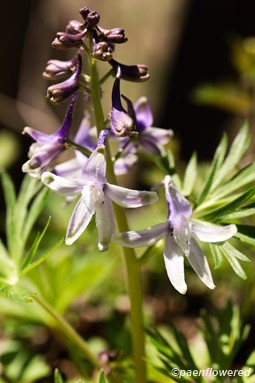
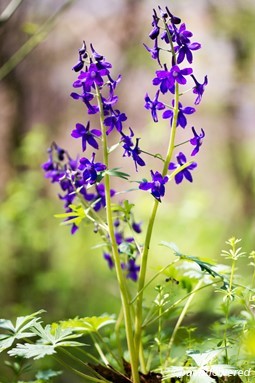
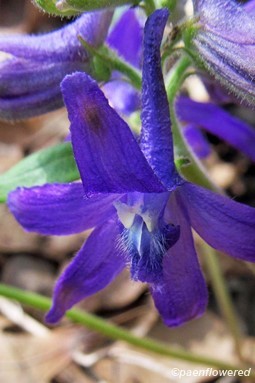
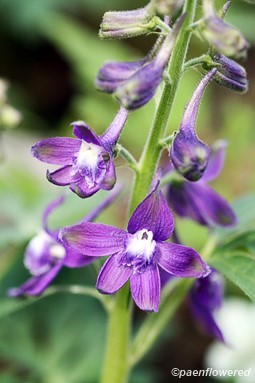
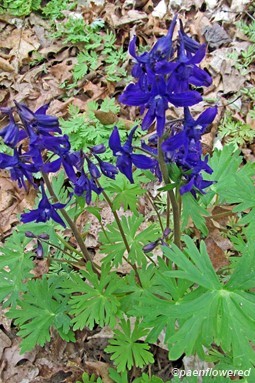

Comments
Have you spotted this plant in your area? We'd love to hear about your experience! Share your comments or questions about the plant below. Comments are moderated before posting.